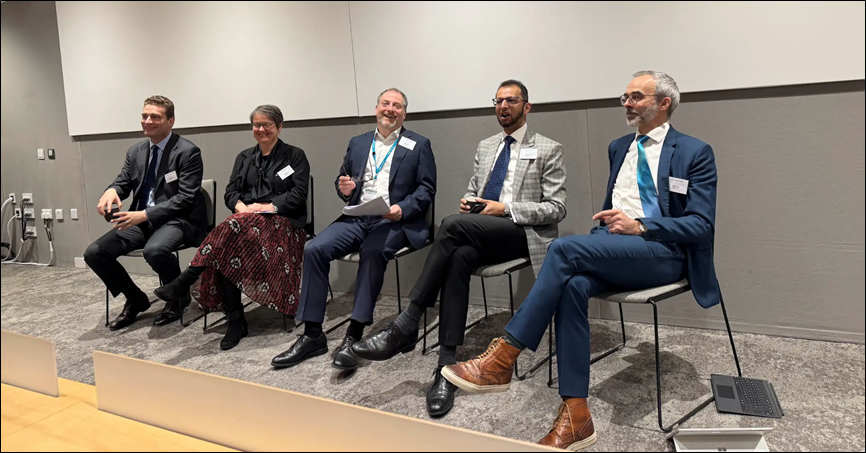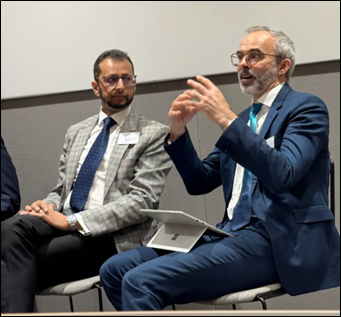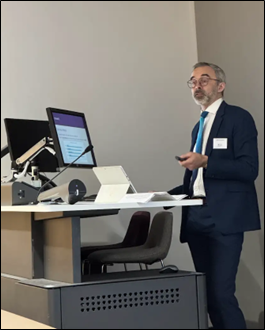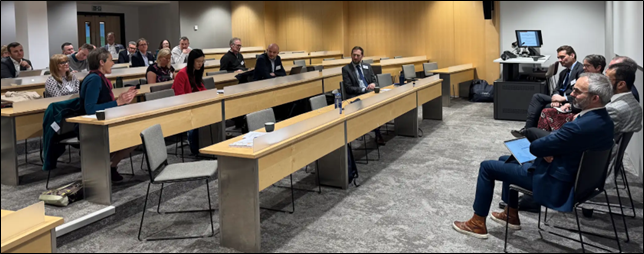On Thursday, 10 April, Julian Chamberlayne, Head of International Injury and Aviation, and Rebecca Hill, Legal Director in the Personal Injury team, attended a one-day workshop hosted by the Centre for Actuarial Compensation and Valuation of Life (CAVOL).
The workshop brought together industry experts and academics to discuss the topic ‘What is Life Worth? Fairer Compensation for Personal Injury and Death’, focusing on the recently updated personal injury discount rate and periodical payment orders. Julian Chamberlayne presented on the topic of ‘Challenging the Personal Injury Discount Rate’ and took part in a panel discussion that included the Government Actuary Fiona Dunsire. Rebecca Hill summarises the key learning points from the day.

Discount Rate discussion panel (from left) William Latimer-Sayer KC (Cloisters, Chair of the Ogden Working Party), Fiona Dunsire (Government Actuary at the Government Actuary’s Department), Prof Alexander J. McNeil (CAVOL, York University), Mohammad Khan (PwC, Chair of the IFoA’s Ogden Discount Rate Working Party), and Julian Chamberlayne (Stewarts, Chair of FOCIS)
Setting the personal injury discount rate
The personal injury discount rate (“PIDR”) plays a significant part in calculating the compensation of seriously injured claimants. In England and Wales, the rate is set by the Lord Chancellor under the Civil Liability Act 2018 (“the CLA 2018”). The CLA 2018 also requires the creation of an expert panel to advise the Lord Chancellor on setting the rate. Notably, in Scotland and Northern Ireland, the Government Actuary sets the rate rather than the Lord Chancellor, with no requirement for an expert panel. In January 2025, the PIDR was increased from 0.25% to +0.5% in England and Wales. Scotland and Northern Ireland had adopted a PIDR of +0.5% a few months earlier.
The Government Actuary (GA), Fiona Dunsire, chaired the expert panel and gave a talk at the CAVOL workshop to outline the approach taken by the panel when formulating recommendations for the PIDR in England and Wales. The approach was underpinned by three core considerations:
- A call for evidence, which sought information from stakeholders on the characteristics and decision-making strategies of claimants.
- Appropriate assumptions for a range of core claimant types derived from the data and evidence collected in the call for evidence.
- Quantified claimant outcomes provided to the Lord Chancellor to inform the decision.
As well as considering the characteristics of claimants, the GA confirmed that the data provided on investment portfolios, damages inflation, taxation and expenses in the responses to the call for evidence were useful to the rate-setting process. This informed changes to the process from 2019, including the use of median investment management fees rather than the lowest possible fees (which were used in 2019) in a bid to recognise the difference between active and passive approaches to the management of investment portfolios.
Underpinning this approach, the expert panel prioritised levels of over and under-compensation according to a broad hierarchy. It was agreed that there should be at least a 50% likelihood of 100% compensation. With this in mind, avoiding significant under-compensation (less than 90% compensation) was given greater weight than limiting over-compensation (greater than 120% compensation).
As the UK’s leading catastrophic injury law firm, Stewarts has always looked to influence government policies that impact seriously injured people. Stewarts submitted a detailed and data-backed response to the call for evidence. Our full response is available to read here.
The GA acknowledged the importance of the data provided in the call for evidence. In particular, the data from the Forum of Complex Injury Solicitors, to which Stewarts contributed, provided insight to the expert panel on the breakdown of awards by heads of loss. Data of that type was particularly useful as it had not been available when the discount rate was set in 2019. She also confirmed that the Government Actuary’s Department (GAD) sought permission to use some of the data provided in the call for evidence for England and Wales in the review of the rates in Scotland and Northern Ireland.
The GA reflected on what more can be done to improve the data received in future reviews. These reflections included:
- Early engagement with stakeholders in relation to the data and evidence received to expand the input further.
- Promoting an increased understanding of the claimant universe.
- Further information on the investment approaches of a wider range of claimants.
- Improved data on post-settlement, particularly relating to investment issues, investment charges, taxation and whether claimants might run out of money earlier than expected.
- Continued consideration of the pros and cons of dual or multiple rates.
Challenging the personal injury discount rate
Given the fundamental influence of the PIDR on compensation levels for the most seriously injured claimants, it is vital that the process is not only truly consistent with the principle of full compensation but also remains as transparent as possible. In his presentation, Julian Chamberlayne explored potentially contentious elements of the decision-making process for the PIDR.
Firstly, earnings inflation was assumed at just +1.25-1.5 percentage points, a departure from the Office for Budget Responsibility’s long-term projections of earnings inflation stabilising at +1.8 percentage points from 2036. The evidence used in making this assumption came from Professor Victoria Wass (an independent expert), Oxford Economics (on behalf of the Association of British Insurers) and the GAD’s own technical committee. Julian questioned whether the Lord Chancellor may have failed to meet the requirement under the Civil Liability Act 2018 to consult with the Treasury in conducting the review. He also highlighted that while almost all other assumptions (eg investment terms and strategies, incomes and lump sum sizes) varied for each of the three core claimant types, the same earnings inflation differential was applied to the 20, 40 and 60-year periods.
Julian examined the assumptions relating to investment portfolios, in which it was assumed a claimant with a £5m lump sum and an investment term of 60 years would take a less cautious approach to investment. Under this approach, the expert report assumes that 60% of the claimant’s future losses would be invested in higher-risk asset classes. However, under the CLA 2018, the Lord Chancellor must assume that relevant damages are invested using an approach that involves (i) more risk than a very low level of risk but (ii) less risk that would ordinarily be accepted by a prudent and properly advised individual investor who has different financial aims. It is questionable whether assuming that a vulnerable claimant, with an award usually associated with significant disability, should be exposed to 60% higher risk assets is both reasonable and compatible with the CLA 2018.
Further analysis from Julian Chamberlayne on the potential weak spots underpinning the process of determining the PIDR under the CLA 2018 is available here.
Julian concluded his talk by querying whether the government may realise that this aspect of CLA 2018 was a mistake and that, as per the preceding Wells v Wells methodology, it is far simpler and better to avoid speculating about investment risk, behaviour and returns. He observed that, ironically, applying the Wells methodology coupled with the Consumer Price Index (CPI) +1% adjustment would have led to the same +0.5% discount rate but by a much less contentious route.
Periodical payment orders
With the new rate increasing the risk of under-compensation across a claimant’s lifetime, continued importance should be placed on the availability of periodical payment orders (PPOs) to provide greater certainty to claimants and mitigate investment risk. John Mead, Technical Claims Director at NHS Resolution (NHSR), and David Roberts, a partner at DAC Beachcroft and an NHSR panel solicitor, reflected on the use and evolution of PPOs.
NHSR continues to emphasise its willingness to settle claims on a PPO basis. With 2861 PPOs currently in place (as of 31 December 2024), NHSR has more PPOs than any other indemnifier in the UK. Justin Thomas of the Institute and Faculty of Actuaries (IFoA) PPO working group explained that insurers continue to demonstrate a reluctance to embrace the PPO regime fully, estimating that the cost to insurers is about 20% higher. A typical mid-sized insurer might have less than 10 PPOs, and while there is a reinsurance market that can buy that exposure, it is expensive. He also explained that the accounting requirements to comply with Solvency 2 require insurers to maintain reserves for 1 in 200 events.
Stewarts has urged the Ministry of Justice to take separate steps to make PPOs more accessible to claimants with serious injuries in the response to the call for evidence.
Future developments
PPOs provide stability and predictability for claimants, which become all the more important against a growing backdrop of uncertainty in the social care sector. Victoria Wass, Professor Emerita at Cardiff University, examined the growing disparity between supply and demand in the care sector, with increasing life expectancy, the impacts of austerity, suppressed local authority funding and poor recruitment rates. The continued increase in demand on the social care sector will likely have trickle-down effects for claimants, particularly as the future costs of care remain unpredictable. Professor Wass acknowledged that the current market pay for carers reflected in the Annual Survey of Hours and Earnings (ASHE), which is used to index periodical payments for care, may need to be uplifted by seriously injured claimants to recruit the support workers they need.
The workshop concluded with an update on the third generation of research into reduction factors for disability in the workplace, derived from labour force survey data compiled by the Office for National Statistics. The research, led by Dr Şule Şahin, Director of CAVOL, and Professor Wass, has identified a notable increase in disability prevalence, rising from 20.2% in 2020 to 24.2% in 2024, likely because of behavioural, cultural and social changes. They estimate the research will be concluded next year. This will be reflected in a new edition of the Ogden Tables.
Stewarts continues to engage with the Ministry of Justice and key stakeholders across the industry to ensure that claimants with life-changing injuries are given a voice on the important issues that affect them and that their needs are taken into account. We will continue to encourage the government to take action to ensure claimants are fully compensated.
We would like to extend our thanks to CAVOL and the speakers for their contributions to the workshop.
You can find further information regarding our expertise, experience and team on our Personal Injury pages.
If you require assistance from our team, please contact us.
Subscribe – In order to receive our news straight to your inbox, subscribe here. Our newsletters are sent no more than once a month.






